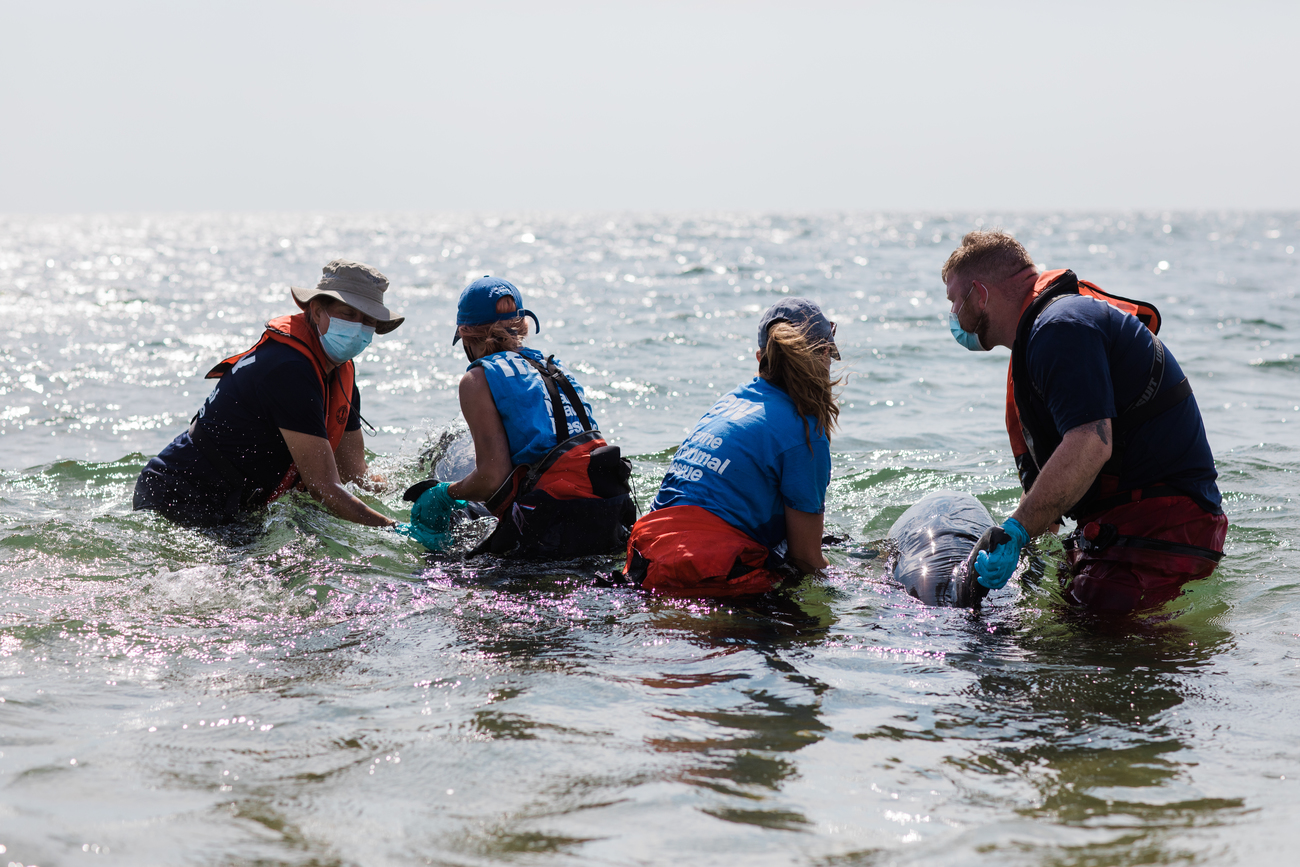a rescue story unlike any other: responding to a 45-dolphin mass stranding event
a rescue story unlike any other: responding to a 45-dolphin mass stranding event

As someone who often mans the 24-hour hotline, I’m accustomed to early morning calls reporting various marine mammal strandings. Even still, I doubt I could have fully prepared for this call. August 9th at 8:01 am was the first time my jaw physically dropped when manning the hotline. The harbormaster reported 30 stranded dolphins in one of the trickiest areas of Wellfleet, the infamous stranding hotspot that traps dolphins with its hook-shaped topography and extreme tides. I asked the harbormaster to repeat himself; sure enough, he was witnessing the dolphins himself. I wasn’t going to await photo confirmation. I immediately dispatched all personnel we had and sent out the call for any additional help we could gather.
Arriving at the scene of the mass stranding
Our team converged at our Rescue Operations Center in waves, grabbing all the specialized equipment we possibly could, as we piled into trucks and got on the road as soon as possible. Our trained volunteer responders arrived on the scene shortly after the initial report to give me updated information — 45 dolphins total, 43 of which were alive. Our teams were en route. In the meantime, our volunteers worked diligently to provide supportive care to the animals prior to staff arriving on-scene.
With a stranding this large, it wasn’t feasible to extract all 43 animals from the mud, get them to our mobile veterinary clinic, and transport them for release at a more favorable open-ocean location all before the tide came in. We were going to have to adapt and fast. Tide was coming in quickly, and the day was getting hotter. The animals had been stranded awhile before the call came in, as all were already suffering from both heat and sun exposure.
Upon getting on the scene, there was no time to react to the sheer chaos that lay ahead. After a quick scan of the situation — 45 animals widely dispersed, only a few staff members and several volunteers – there wasn’t a second more to linger. We began the grueling process of getting as many animals as we could into custom slings, onto the cart, and off the marsh as quickly as possible. This was not without its own challenges. The mud trapped and enveloped your feet adding weight with each step, most animals were highly fractious when approached, and the heat became oppressive in dry suits and Covid-19 PPE. None of that was going to stop us from doing all we could for these animals.
Racing against the tide to rescue dolphins
We worked tirelessly to extract the least stable animals two at a time, managing to get 11 animals into our veterinary trailer for much-needed clinical care. Concurrently, we were providing supportive care to the remaining animals, all while losing personnel to help care for dolphins in the trailer. After three animals were extracted, the water had flooded enough that most animals were mobilizing. So began what can only be described as the most athletic event of my life. All animals were struggling to keep their blowhole above water, writhing in the sticky mud. The team worked unceasingly to keep the animals safe. With a person-to-dolphin ratio of roughly 1:7, we ran from animal to animal, situating them upright to breathe, only to have them roll moments later and again need help. The extensive activity turned the water opaque, requiring us to blindly feel for the animals. This went on for over an hour, while simultaneously extracting animals before the tide fully came in. The dolphins re-acclimatized and started to swim on their own with the rising tide. Our team worked to encourage the remaining 30 dolphins off towards deeper water. Knowing that dolphins often re-strand once pushed off, vessel support was on standby to shepherd the animals out of precarious waters.
While vessel teams worked with the swimming animals, we went to release the extracted animals after they’d received vital clinical care. Unfortunately, due to the heat and shock of the stranding event, two animals had to be humanely euthanized to prevent further suffering. Thankfully, despite the traumatic impacts of the stranding event, nine animals were deemed good release candidates. Exhausted and determined, we transported each animal to a nearby beach with better access to deep water. As we pushed them all off, every challenge we faced that day faded away as we watched nine remarkable, resilient animals swim out towards deeper waters and hopefully towards a successful second chance.
A note of gratitude to our rescue volunteer and supporters
We want to express our deepest appreciation for the support we received throughout this massive event. The National Parks Service, the Wellfleet Harbormasters, the Wellfleet Police Department, the general public, and of course, our amazing volunteers all played crucial roles in the success of this response. It takes extensive partnership and coordination to carry out the work we do, and we’d like to thank the many people who helped us, both during the initial response as well as during the following week.
-Kira Kasper, Stranding Technician, Marine Mammal Rescue & Research
Related content
Every problem has a solution, every solution needs support.
The problems we face are urgent, complicated, and resistant to change. Real solutions demand creativity, hard work and involvement from people like you.